Analysis of Self-Care Educational Intervention for Heart Failure
VerifiedAdded on 2022/08/17
|8
|1217
|17
Homework Assignment
AI Summary
This assignment critically appraises the randomized controlled trial by Boyde et al. (2018) on a self-care educational intervention for heart failure patients. Part A consists of multiple-choice and comprehension questions based on the CASP checklist for randomized controlled trials, assessing the study's methodology, results, and potential biases. Part B requires a written analysis, summarizing the study's rigor, internal validity, limitations, and adherence to the intervention. The study recruited 200 patients, comparing a multimedia educational intervention (DVD, manual, discussions) to standard care, with outcomes measured at 28 days, 3 months, and 12 months. Key findings include a potential reduction in unplanned readmissions at 12 months. The assignment evaluates the study's design, implementation, and implications for healthcare practices, focusing on factors such as patient selection, intervention strategies, and the validity of the results. The assignment also considers the study's limitations, including the single-site research and reliance on telephone-based questionnaires, and compliance with the intervention.
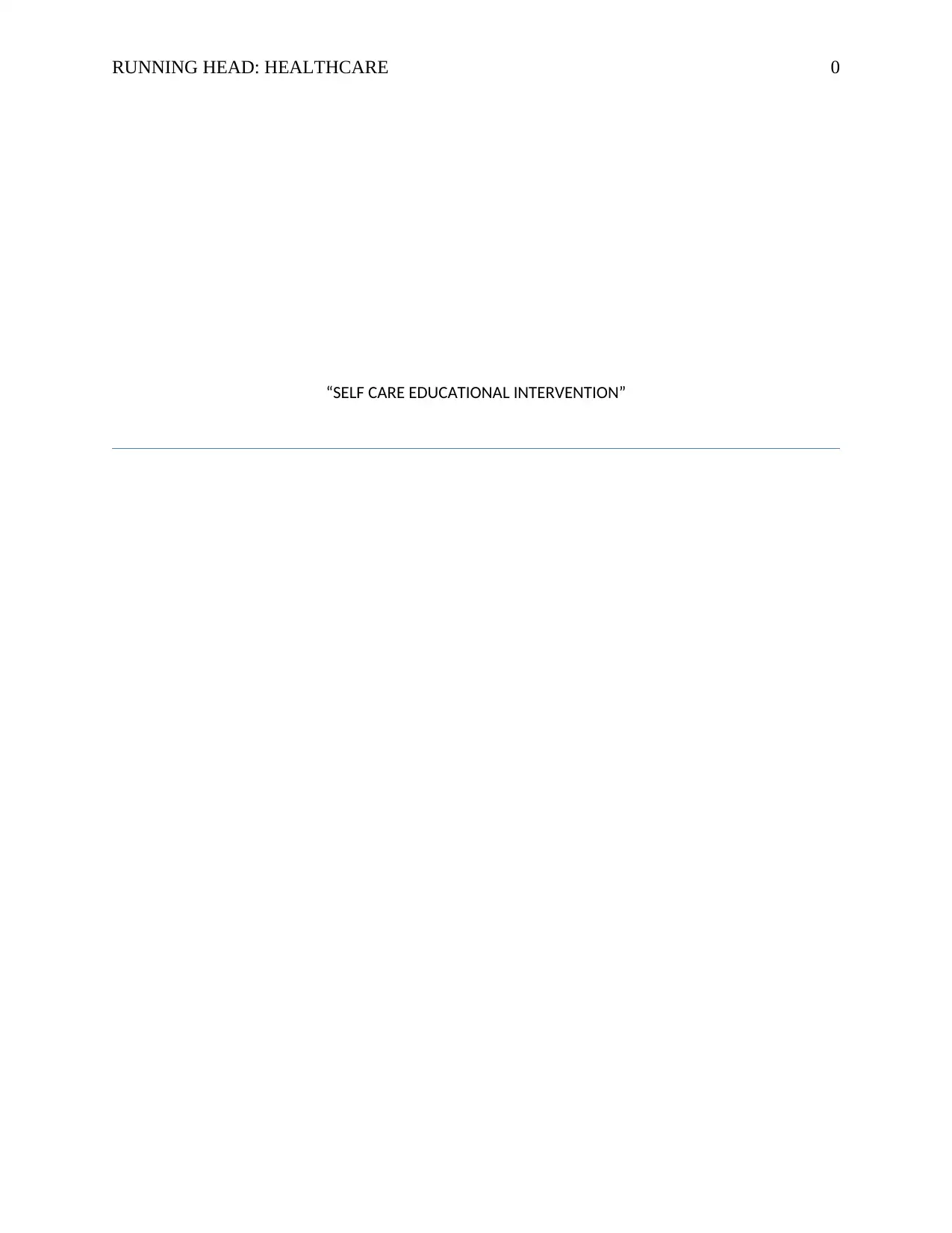
RUNNING HEAD: HEALTHCARE 0
“SELF CARE EDUCATIONAL INTERVENTION”
“SELF CARE EDUCATIONAL INTERVENTION”
Paraphrase This Document
Need a fresh take? Get an instant paraphrase of this document with our AI Paraphraser
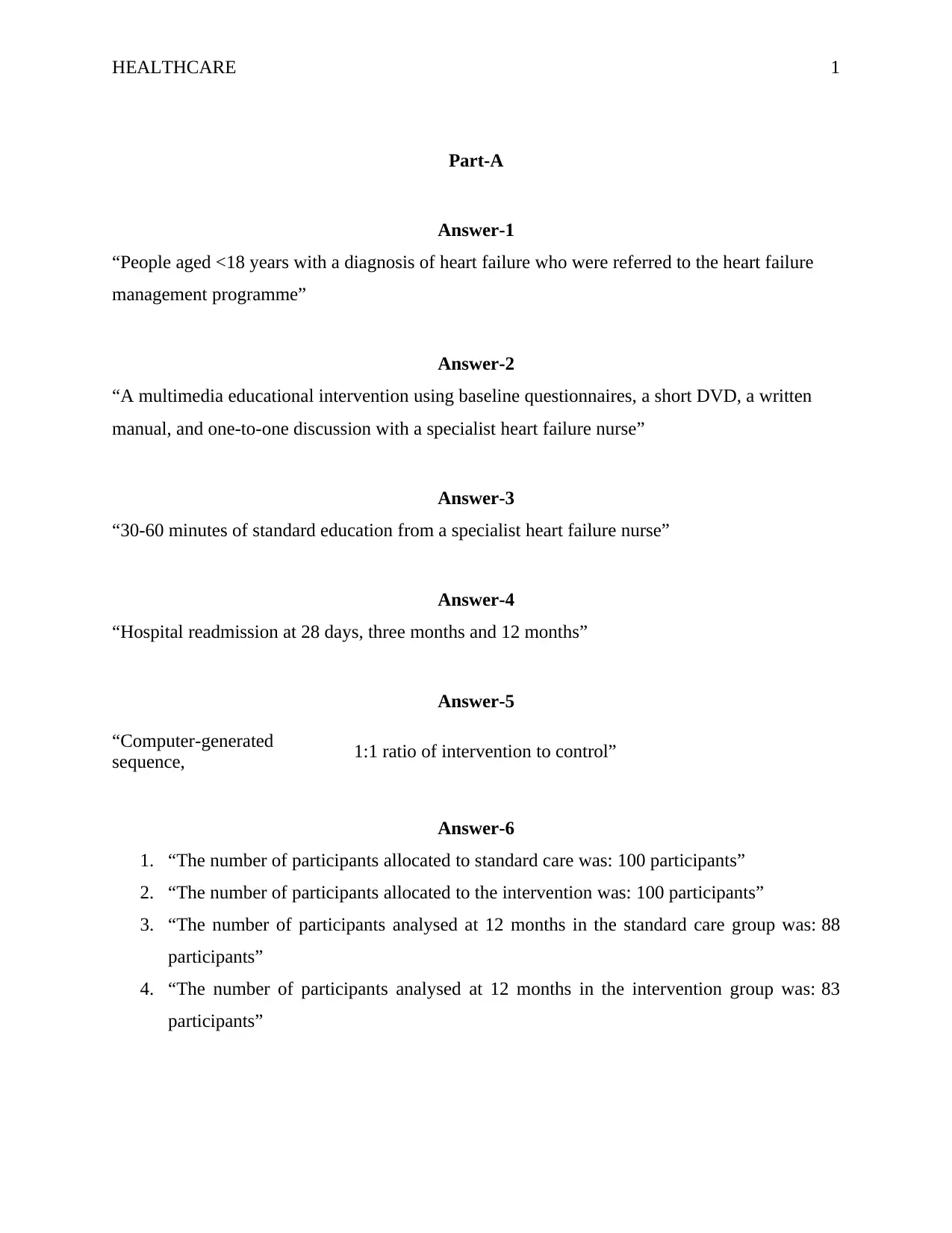
HEALTHCARE 1
Part-A
Answer-1
“People aged <18 years with a diagnosis of heart failure who were referred to the heart failure
management programme”
Answer-2
“A multimedia educational intervention using baseline questionnaires, a short DVD, a written
manual, and one-to-one discussion with a specialist heart failure nurse”
Answer-3
“30-60 minutes of standard education from a specialist heart failure nurse”
Answer-4
“Hospital readmission at 28 days, three months and 12 months”
Answer-5
“Computer-generated
sequence, 1:1 ratio of intervention to control”
Answer-6
1. “The number of participants allocated to standard care was: 100 participants”
2. “The number of participants allocated to the intervention was: 100 participants”
3. “The number of participants analysed at 12 months in the standard care group was: 88
participants”
4. “The number of participants analysed at 12 months in the intervention group was: 83
participants”
Part-A
Answer-1
“People aged <18 years with a diagnosis of heart failure who were referred to the heart failure
management programme”
Answer-2
“A multimedia educational intervention using baseline questionnaires, a short DVD, a written
manual, and one-to-one discussion with a specialist heart failure nurse”
Answer-3
“30-60 minutes of standard education from a specialist heart failure nurse”
Answer-4
“Hospital readmission at 28 days, three months and 12 months”
Answer-5
“Computer-generated
sequence, 1:1 ratio of intervention to control”
Answer-6
1. “The number of participants allocated to standard care was: 100 participants”
2. “The number of participants allocated to the intervention was: 100 participants”
3. “The number of participants analysed at 12 months in the standard care group was: 88
participants”
4. “The number of participants analysed at 12 months in the intervention group was: 83
participants”
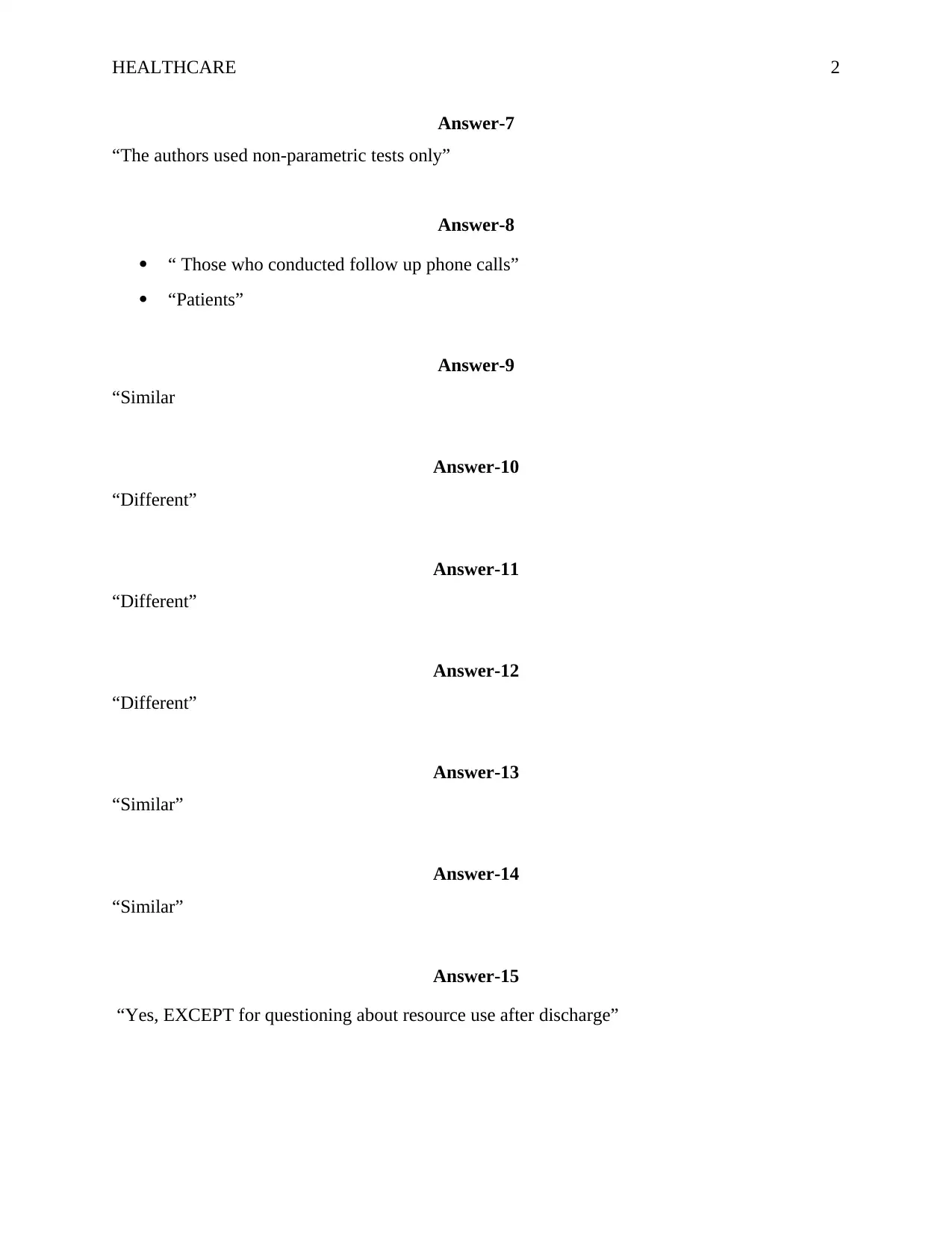
HEALTHCARE 2
Answer-7
“The authors used non-parametric tests only”
Answer-8
“ Those who conducted follow up phone calls”
“Patients”
Answer-9
“Similar
Answer-10
“Different”
Answer-11
“Different”
Answer-12
“Different”
Answer-13
“Similar”
Answer-14
“Similar”
Answer-15
“Yes, EXCEPT for questioning about resource use after discharge”
Answer-7
“The authors used non-parametric tests only”
Answer-8
“ Those who conducted follow up phone calls”
“Patients”
Answer-9
“Similar
Answer-10
“Different”
Answer-11
“Different”
Answer-12
“Different”
Answer-13
“Similar”
Answer-14
“Similar”
Answer-15
“Yes, EXCEPT for questioning about resource use after discharge”
⊘ This is a preview!⊘
Do you want full access?
Subscribe today to unlock all pages.

Trusted by 1+ million students worldwide
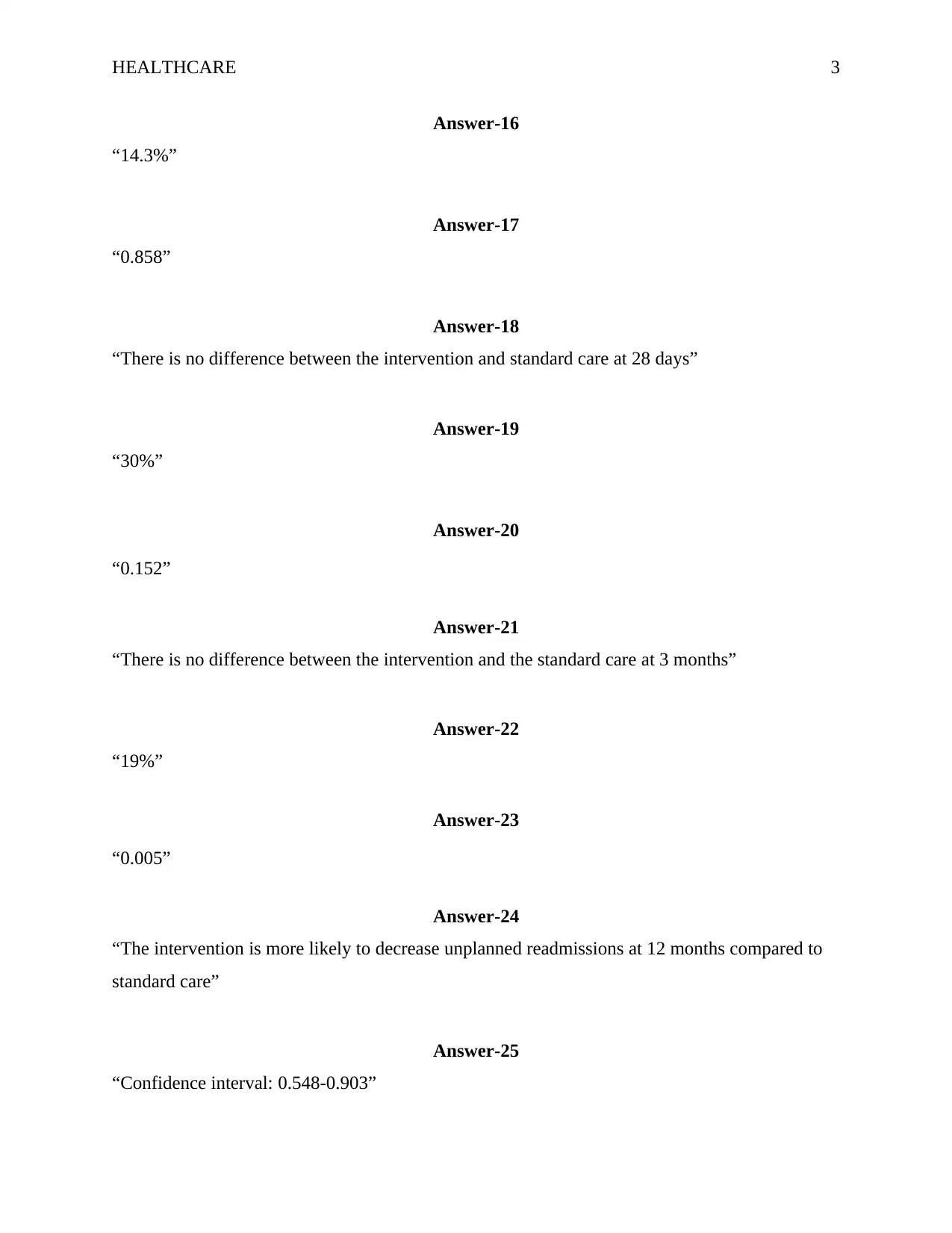
HEALTHCARE 3
Answer-16
“14.3%”
Answer-17
“0.858”
Answer-18
“There is no difference between the intervention and standard care at 28 days”
Answer-19
“30%”
Answer-20
“0.152”
Answer-21
“There is no difference between the intervention and the standard care at 3 months”
Answer-22
“19%”
Answer-23
“0.005”
Answer-24
“The intervention is more likely to decrease unplanned readmissions at 12 months compared to
standard care”
Answer-25
“Confidence interval: 0.548-0.903”
Answer-16
“14.3%”
Answer-17
“0.858”
Answer-18
“There is no difference between the intervention and standard care at 28 days”
Answer-19
“30%”
Answer-20
“0.152”
Answer-21
“There is no difference between the intervention and the standard care at 3 months”
Answer-22
“19%”
Answer-23
“0.005”
Answer-24
“The intervention is more likely to decrease unplanned readmissions at 12 months compared to
standard care”
Answer-25
“Confidence interval: 0.548-0.903”
Paraphrase This Document
Need a fresh take? Get an instant paraphrase of this document with our AI Paraphraser
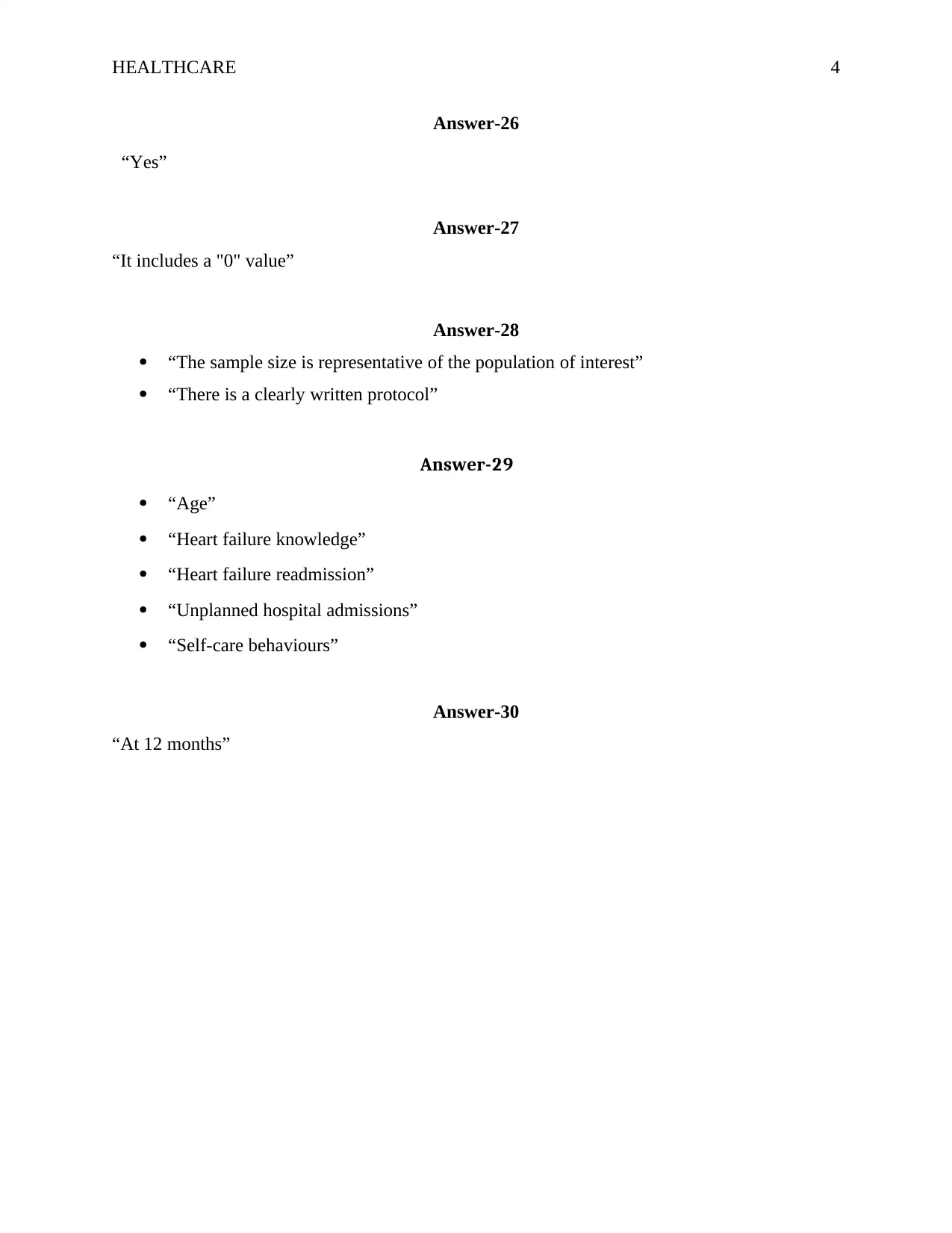
HEALTHCARE 4
Answer-26
“Yes”
Answer-27
“It includes a "0" value”
Answer-28
“The sample size is representative of the population of interest”
“There is a clearly written protocol”
Answer-29
“Age”
“Heart failure knowledge”
“Heart failure readmission”
“Unplanned hospital admissions”
“Self-care behaviours”
Answer-30
“At 12 months”
Answer-26
“Yes”
Answer-27
“It includes a "0" value”
Answer-28
“The sample size is representative of the population of interest”
“There is a clearly written protocol”
Answer-29
“Age”
“Heart failure knowledge”
“Heart failure readmission”
“Unplanned hospital admissions”
“Self-care behaviours”
Answer-30
“At 12 months”
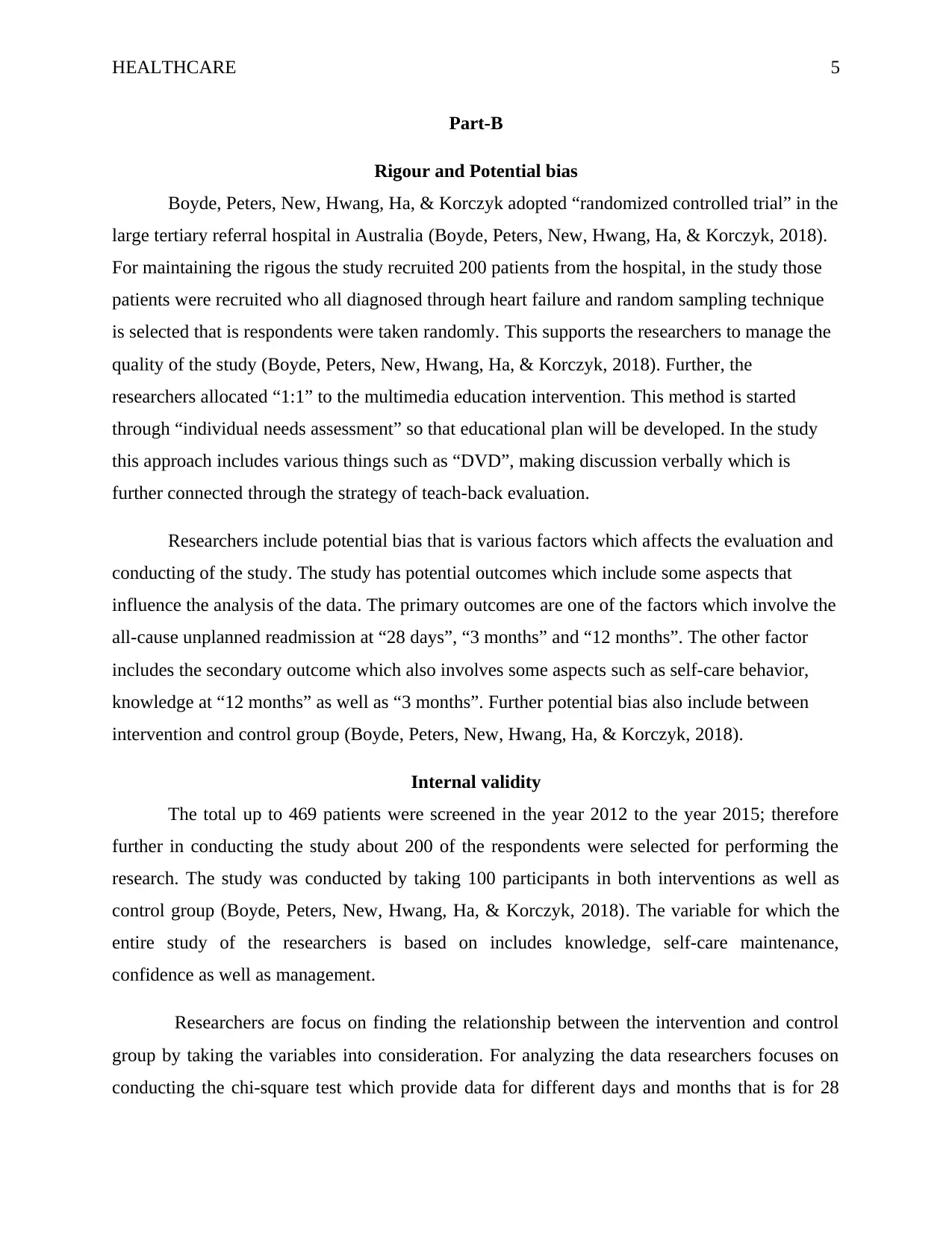
HEALTHCARE 5
Part-B
Rigour and Potential bias
Boyde, Peters, New, Hwang, Ha, & Korczyk adopted “randomized controlled trial” in the
large tertiary referral hospital in Australia (Boyde, Peters, New, Hwang, Ha, & Korczyk, 2018).
For maintaining the rigous the study recruited 200 patients from the hospital, in the study those
patients were recruited who all diagnosed through heart failure and random sampling technique
is selected that is respondents were taken randomly. This supports the researchers to manage the
quality of the study (Boyde, Peters, New, Hwang, Ha, & Korczyk, 2018). Further, the
researchers allocated “1:1” to the multimedia education intervention. This method is started
through “individual needs assessment” so that educational plan will be developed. In the study
this approach includes various things such as “DVD”, making discussion verbally which is
further connected through the strategy of teach-back evaluation.
Researchers include potential bias that is various factors which affects the evaluation and
conducting of the study. The study has potential outcomes which include some aspects that
influence the analysis of the data. The primary outcomes are one of the factors which involve the
all-cause unplanned readmission at “28 days”, “3 months” and “12 months”. The other factor
includes the secondary outcome which also involves some aspects such as self-care behavior,
knowledge at “12 months” as well as “3 months”. Further potential bias also include between
intervention and control group (Boyde, Peters, New, Hwang, Ha, & Korczyk, 2018).
Internal validity
The total up to 469 patients were screened in the year 2012 to the year 2015; therefore
further in conducting the study about 200 of the respondents were selected for performing the
research. The study was conducted by taking 100 participants in both interventions as well as
control group (Boyde, Peters, New, Hwang, Ha, & Korczyk, 2018). The variable for which the
entire study of the researchers is based on includes knowledge, self-care maintenance,
confidence as well as management.
Researchers are focus on finding the relationship between the intervention and control
group by taking the variables into consideration. For analyzing the data researchers focuses on
conducting the chi-square test which provide data for different days and months that is for 28
Part-B
Rigour and Potential bias
Boyde, Peters, New, Hwang, Ha, & Korczyk adopted “randomized controlled trial” in the
large tertiary referral hospital in Australia (Boyde, Peters, New, Hwang, Ha, & Korczyk, 2018).
For maintaining the rigous the study recruited 200 patients from the hospital, in the study those
patients were recruited who all diagnosed through heart failure and random sampling technique
is selected that is respondents were taken randomly. This supports the researchers to manage the
quality of the study (Boyde, Peters, New, Hwang, Ha, & Korczyk, 2018). Further, the
researchers allocated “1:1” to the multimedia education intervention. This method is started
through “individual needs assessment” so that educational plan will be developed. In the study
this approach includes various things such as “DVD”, making discussion verbally which is
further connected through the strategy of teach-back evaluation.
Researchers include potential bias that is various factors which affects the evaluation and
conducting of the study. The study has potential outcomes which include some aspects that
influence the analysis of the data. The primary outcomes are one of the factors which involve the
all-cause unplanned readmission at “28 days”, “3 months” and “12 months”. The other factor
includes the secondary outcome which also involves some aspects such as self-care behavior,
knowledge at “12 months” as well as “3 months”. Further potential bias also include between
intervention and control group (Boyde, Peters, New, Hwang, Ha, & Korczyk, 2018).
Internal validity
The total up to 469 patients were screened in the year 2012 to the year 2015; therefore
further in conducting the study about 200 of the respondents were selected for performing the
research. The study was conducted by taking 100 participants in both interventions as well as
control group (Boyde, Peters, New, Hwang, Ha, & Korczyk, 2018). The variable for which the
entire study of the researchers is based on includes knowledge, self-care maintenance,
confidence as well as management.
Researchers are focus on finding the relationship between the intervention and control
group by taking the variables into consideration. For analyzing the data researchers focuses on
conducting the chi-square test which provide data for different days and months that is for 28
⊘ This is a preview!⊘
Do you want full access?
Subscribe today to unlock all pages.

Trusted by 1+ million students worldwide
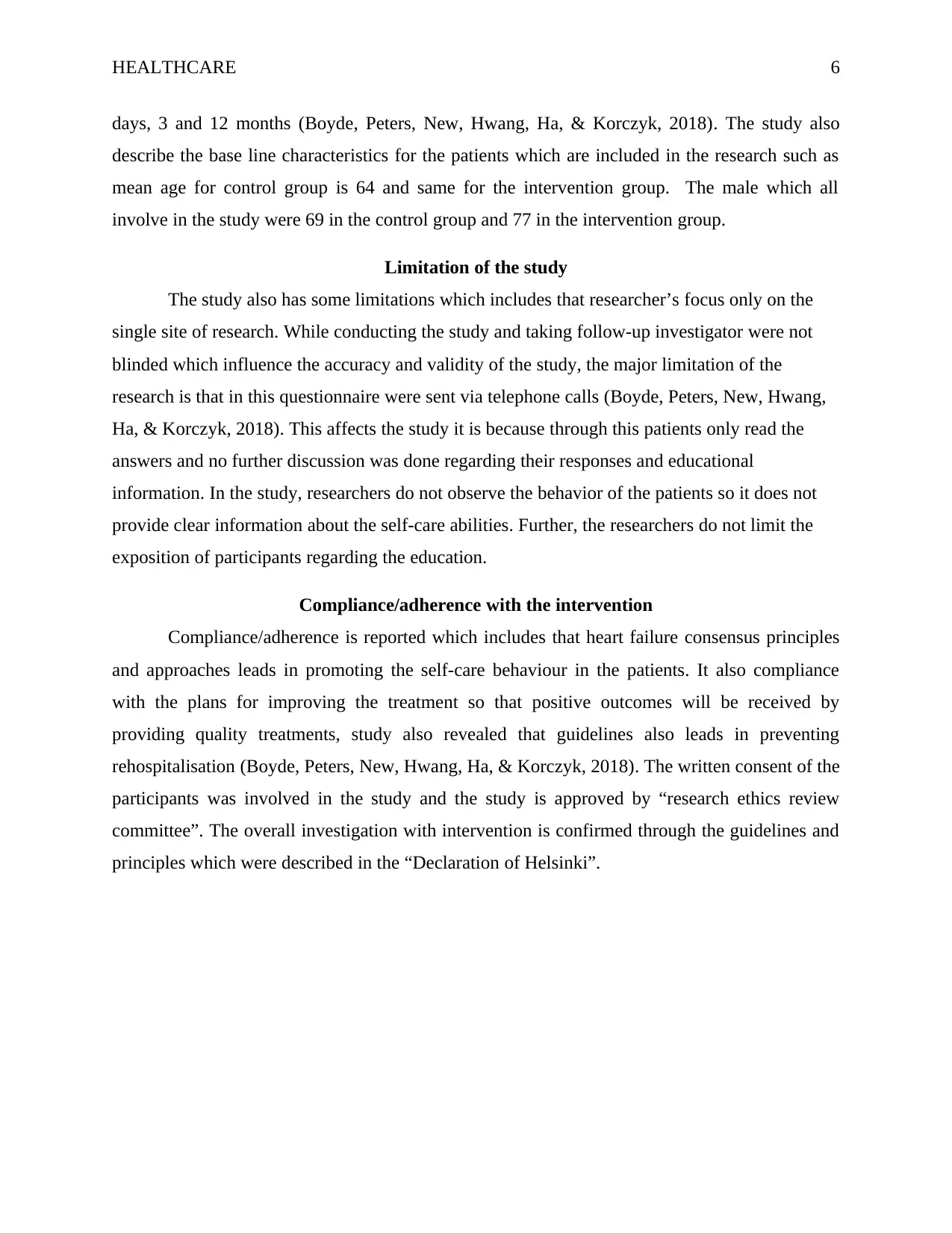
HEALTHCARE 6
days, 3 and 12 months (Boyde, Peters, New, Hwang, Ha, & Korczyk, 2018). The study also
describe the base line characteristics for the patients which are included in the research such as
mean age for control group is 64 and same for the intervention group. The male which all
involve in the study were 69 in the control group and 77 in the intervention group.
Limitation of the study
The study also has some limitations which includes that researcher’s focus only on the
single site of research. While conducting the study and taking follow-up investigator were not
blinded which influence the accuracy and validity of the study, the major limitation of the
research is that in this questionnaire were sent via telephone calls (Boyde, Peters, New, Hwang,
Ha, & Korczyk, 2018). This affects the study it is because through this patients only read the
answers and no further discussion was done regarding their responses and educational
information. In the study, researchers do not observe the behavior of the patients so it does not
provide clear information about the self-care abilities. Further, the researchers do not limit the
exposition of participants regarding the education.
Compliance/adherence with the intervention
Compliance/adherence is reported which includes that heart failure consensus principles
and approaches leads in promoting the self-care behaviour in the patients. It also compliance
with the plans for improving the treatment so that positive outcomes will be received by
providing quality treatments, study also revealed that guidelines also leads in preventing
rehospitalisation (Boyde, Peters, New, Hwang, Ha, & Korczyk, 2018). The written consent of the
participants was involved in the study and the study is approved by “research ethics review
committee”. The overall investigation with intervention is confirmed through the guidelines and
principles which were described in the “Declaration of Helsinki”.
days, 3 and 12 months (Boyde, Peters, New, Hwang, Ha, & Korczyk, 2018). The study also
describe the base line characteristics for the patients which are included in the research such as
mean age for control group is 64 and same for the intervention group. The male which all
involve in the study were 69 in the control group and 77 in the intervention group.
Limitation of the study
The study also has some limitations which includes that researcher’s focus only on the
single site of research. While conducting the study and taking follow-up investigator were not
blinded which influence the accuracy and validity of the study, the major limitation of the
research is that in this questionnaire were sent via telephone calls (Boyde, Peters, New, Hwang,
Ha, & Korczyk, 2018). This affects the study it is because through this patients only read the
answers and no further discussion was done regarding their responses and educational
information. In the study, researchers do not observe the behavior of the patients so it does not
provide clear information about the self-care abilities. Further, the researchers do not limit the
exposition of participants regarding the education.
Compliance/adherence with the intervention
Compliance/adherence is reported which includes that heart failure consensus principles
and approaches leads in promoting the self-care behaviour in the patients. It also compliance
with the plans for improving the treatment so that positive outcomes will be received by
providing quality treatments, study also revealed that guidelines also leads in preventing
rehospitalisation (Boyde, Peters, New, Hwang, Ha, & Korczyk, 2018). The written consent of the
participants was involved in the study and the study is approved by “research ethics review
committee”. The overall investigation with intervention is confirmed through the guidelines and
principles which were described in the “Declaration of Helsinki”.
Paraphrase This Document
Need a fresh take? Get an instant paraphrase of this document with our AI Paraphraser
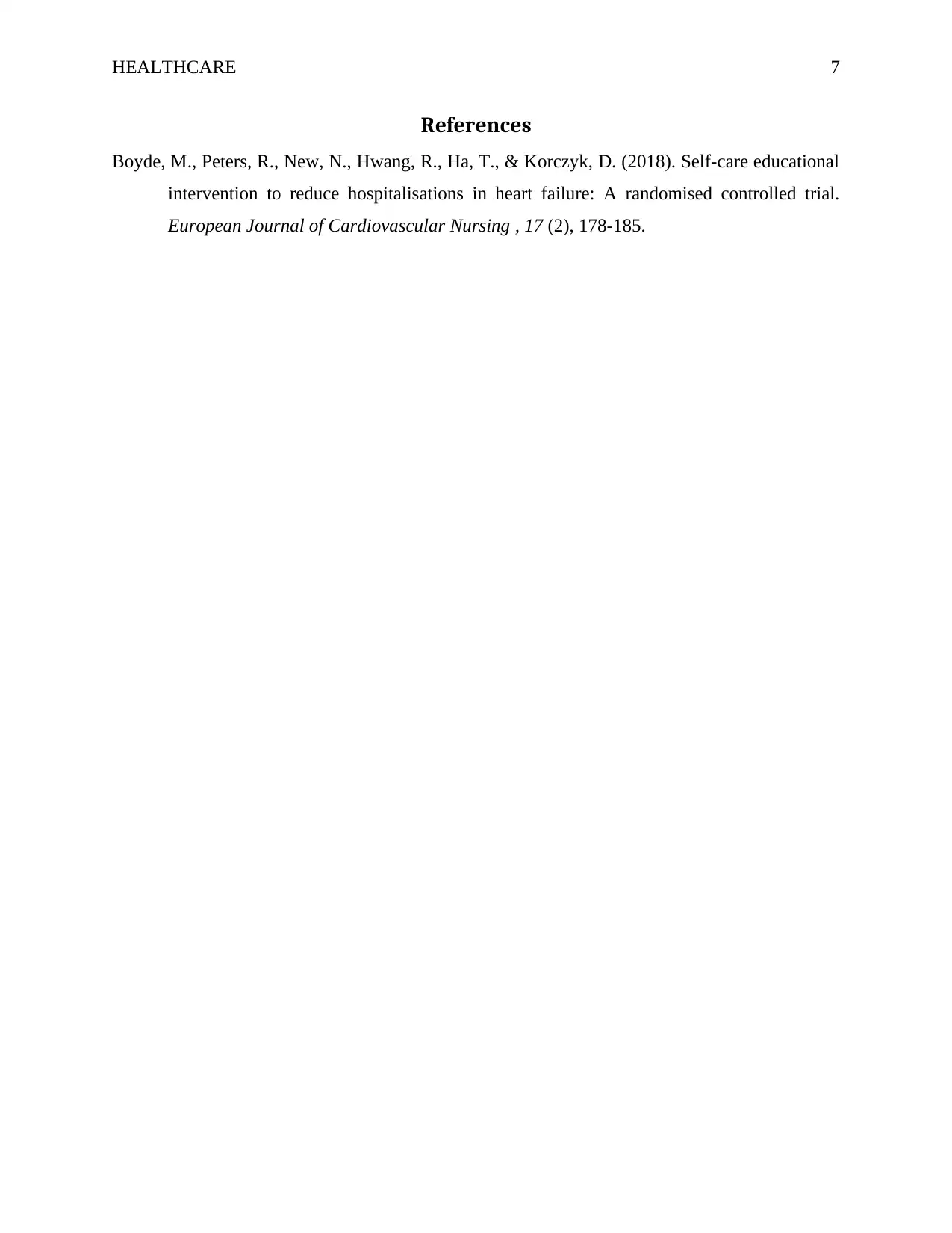
HEALTHCARE 7
References
Boyde, M., Peters, R., New, N., Hwang, R., Ha, T., & Korczyk, D. (2018). Self-care educational
intervention to reduce hospitalisations in heart failure: A randomised controlled trial.
European Journal of Cardiovascular Nursing , 17 (2), 178-185.
References
Boyde, M., Peters, R., New, N., Hwang, R., Ha, T., & Korczyk, D. (2018). Self-care educational
intervention to reduce hospitalisations in heart failure: A randomised controlled trial.
European Journal of Cardiovascular Nursing , 17 (2), 178-185.
1 out of 8
Related Documents
Your All-in-One AI-Powered Toolkit for Academic Success.
+13062052269
info@desklib.com
Available 24*7 on WhatsApp / Email
![[object Object]](/_next/static/media/star-bottom.7253800d.svg)
Unlock your academic potential
Copyright © 2020–2025 A2Z Services. All Rights Reserved. Developed and managed by ZUCOL.





